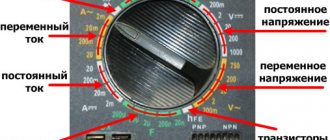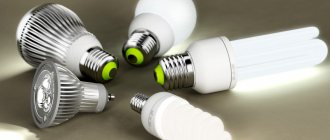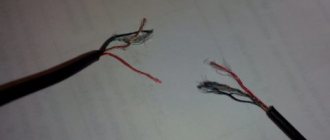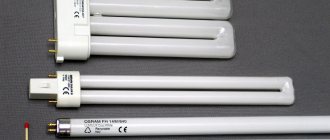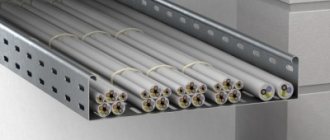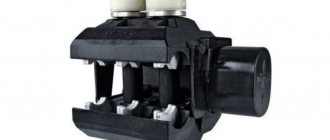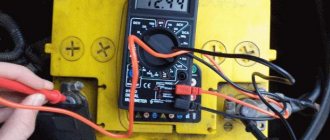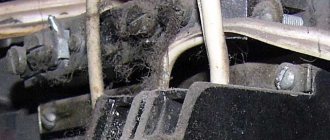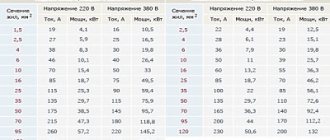Dismantling and installation of wires.
3.1. Work on the dismantling and installation of the wire must be carried out according to the technological map or PPR in the presence of the work manager with group V along the work order. 3.2. Before starting the robot, the foreman must personally inspect the lines and outline measures to ensure safe work. 3.3. It is permissible to proceed with decoupling of wires only after strengthening the defective support using one of the above methods. 3.4. When replacing wires, start decoupling from top to bottom. Having released the ties of the upper wire, lower it to the ground carefully (without jerking) using a rope. The newly suspended wire is lifted onto supports, sighted and tied to the insulators. In this sequence of operations, the remaining wires are dismantled and installed. It is forbidden to untie the last wire until the newly suspended wires are secured. Before removing the wires from the corner support, it is necessary to secure it with a guy rope. If there is a large degree of decay of the supports, it is necessary to use fastening devices or carry out work using a tower, and it is strictly forbidden to attach the dismantled wires, at least temporarily, to the basket or telescope of the tower. 3.5. Do not climb or stand on an intermediate support if less than two wires are attached to it. 3.6. It is prohibited to climb and work on corner supports with pin insulators from the inside corner.
2.5.256
The requirements given in 2.5.256-2.5.263 apply to intersections and approaches with highways:
public use and access roads to industrial enterprises (categories IA, IB, II-V according to building codes and regulations for highways);
on-farm in agricultural enterprises (categories IC - III-C according to building codes and regulations for on-farm roads on collective farms, state farms and other agricultural enterprises and organizations).
The intersection and approach of overhead lines with federal public roads must also comply with the requirements of the rules for the establishment and use of roadside strips of federal public highways.
The angle of intersection with highways is not standardized.
Dismantling supports.
4.1. Work on dismantling supports, as well as replacing support elements, must be carried out according to the technological map or PPR in the presence of the work manager with group V along the way. 4.2. On the eve of the work on dismantling the supports, the foreman must personally inspect the section of the line and outline measures to ensure the safe execution of the work. 4.3. Rejection of supports must be carried out in accordance with the requirements of the instructions “On the rejection of wooden elements of supports” and “On the rejection of reinforced concrete supports and reinforced concrete attachments”. 4.4. The methods for felling the support are determined on site by the worker who issued the work order or the work manager. In addition, before going to work on a 0.4 - 6-10 kV overhead line on reinforced concrete supports, the work manager must check the documentation for the presence of single-phase ground faults on the overhead line. 4.5. Before assigning team members to work stations, the foreman briefs the team. 4.6. When dismantling supports using a truck crane, the sling is secured from a telescopic tower or aerial ladder above the center of gravity of the support, and the slack is removed until tension is reached. The support is released from the bandages and by turning the crane boom it is retracted in the desired direction and lies on the ground or is loaded. 4.7. The truck crane must be installed in such a way that the angle between the axis of rotation and the boom is minimal, the outriggers are set and secured, and people are removed from the work area of the truck crane. 4.8. When felling a support, traction cables and guy ropes must be attached to the upper part of the support before work begins to free the base of the support. 4.10. The tension of the cable when felling the support should be carried out evenly with due care to avoid breaking the cable.
The distance at which power lines are installed to the fence
In the matter of building a house and equipping its territory, many issues are important. This includes the distance from the power line to the fence, which everyone who has started building a fence for their private plot should know about. The safety of those who come to the territory on vacation or permanently reside on the territory depends on the correct calculation of the distance from power lines to the fence of a private house.
Diagram with dimensions of the location of the fence from the power line
Important points
A person uses electricity all the time, be it at home, in the country or in the office. But few people delve into the fact that power lines not only supply a useful resource, but can also be harmful due to magnetic fields, and in case of failures they become unsafe for humans. It is imperative to adhere to the established rules, which indicate the required distance from the support to the fence of a residential private house for the following reasons:
- To preserve the health of building occupants.
- In order not to suffer from the effects of airborne electromagnetic fields that have a detrimental effect on the human brain.
- In the security zone of power lines, where the voltage level is especially dangerous for humans, the issue of locating residential buildings is especially acute. If the level of danger is off the charts, the area is fenced off with an industrial fence and a ban on construction in this area is put in place.
Power line protection zone diagram
Therefore, SNiP establishes distances from power lines to the fence of a house not just so that people do not receive fines for violations, but for the safety of the population of cities and villages.
The sanitary standards related to power lines clearly and in detail describe at what distance from power lines fences can be installed. This distance depends on the voltage level in the wires. In places of special tension, which are specially equipped, there are sanitary zones, near which it is prohibited to place fences and build residential buildings.
Safe distance from power lines
A requirement is established for the distance from the fence at the dacha to the place where the power line support is located, based on the voltage class.
Some owners of private plots turn to city or rural self-government bodies in order to obtain information about the voltage class in power lines located near their summer cottage.
Of course, not knowing how to determine the voltage level in the wires, it is better to do just that, so as not to unwittingly become a violator of SNiP requirements and endanger the residents of a private plot.
However, there is a method by which you can independently determine the voltage level in power poles.
Diagram of voltages in power lines of various types
If the voltage is very small, then it can be determined by counting the insulators.
How to increase your security level
Even having fully complied with all the norms and requirements regarding the distance of the fence from the poles through which electricity passes, houses built near power lines are still at risk in unforeseen situations and must protect their private sectors. This can be done in the following ways:
- Select a roof with grounding for the construction of the house,
- Install reinforcing mesh inside the wall structure. This solution will help reduce the risk of penetration of harmful electromagnetic waves into the living space,
- To increase the level of safety for home residents, fruit trees should be planted at a horizontal distance of at least 2 meters from power lines.
Minimum permissible distances from trees to power lines
Recommendations
The requirements in SNiP are prescribed primarily for the safety of people, and not to fulfill the wishes of self-government bodies. Therefore, you should not neglect safety rules, especially when it comes to electrical voltage.
It is worth paying maximum attention to calculations at what distance it is safe to install a fence from power lines. Only a properly installed fence will provide comfort and limit the residents of a private plot from troubles and danger.
5.REPLACEMENT OF WIRES IN THE SPANS INTERSECTION WITH OTHER OPERATING LINES.
5.1. All work on overhead lines above 1000 V at the intersection with the existing overhead line is carried out side by side under the supervision of the work manager with group V from the managers and specialists servicing this electric power line. installation. 5.2. When performing work on overhead line wires in the span of intersection with another live line, grounding must be installed on the support where the work is being done. When performing work on hanging, replacing or adjusting the wire, it should be grounded on both sides of the intersection. In this case, when replacing wires, it is necessary to ground both the wire being removed and the wire being suspended on both sides of the intersection. 5.3. In the crossing spans of overhead lines, when replacing wires and related insulators and fittings located below live wires, on both sides of the intersection through grounded wires, it is necessary to throw ropes made of plant or synthetic fibers, securing them to anchors, structures, etc. . The wire should be lifted smoothly, without jerking, to avoid tripping the live wires located above. 5.4. In crossing spans on overhead lines, work on supports, insulators and fittings located above live wires must be carried out according to the PPR, which must include measures to prevent the wires from lowering. It is prohibited to replace or adjust the wire when performing such work without removing the voltage from the underlying wires.
Sanitary zones
Electrical transmission lines emit electromagnetic floors that negatively affect human health, plants and animals. Under power lines, starting from 330,000 V, sanitary zones are created. Their width will be 10 meters on all sides. Measurements are taken from the projection of the outermost wire onto the ground. It is forbidden to string high-voltage wires through the air at any height above railway tracks and gas pipelines. If there is a break, there is a high chance of an accident. A gas pipeline running on the ground should under no circumstances intersect with overhead electrical transmission lines. For the crossing there must be underground cable conduction with grounding of the installations at the point of exit and entry of the line. Electricity needs to be supplied to cities and towns through electrical transmission lines.
There may be a parallel pipeline, streets with houses and a highway nearby. The norm for the distance of power lines from them should be from 5 to 10 meters, and the standards are determined by the width of the san. zones. The distance must be calculated taking into account the boundaries of the dacha sector site. There must be a distance of at least 100 meters to residential buildings if the voltage is greater than 35,000 V. All requirements for distances between power lines are described in GOST R 21.1101-2009. On the basis of this regulatory document, all calculations are performed and designs of electrical transmission lines are developed.
2.5.258
Distances when crossing and approaching overhead lines with highways must be no less than those given in Table 2.5.35.
In all cases of approaching curved sections of roads passing along embankments, the minimum distances from the overhead line wires to the edge of the roadbed must be no less than the vertical distances indicated in Table 2.5.35.
The shortest vertical distances in normal operation of overhead lines from the wires to the roadway should be taken:
without taking into account heating of the wire by electric current at the highest air temperature for overhead lines of 500 kV and below, at air temperatures according to 2.5.17 at the maximum permissible values of the intensity of the electric and magnetic components of the electromagnetic field for overhead lines of 750 kV;
at the calculated linear ice load according to 2.5.55 and air temperature during ice conditions according to 2.5.51.
